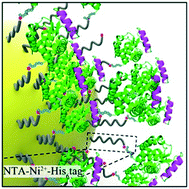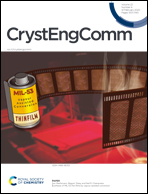Induction of crystal nucleation by orientation-controlled binding of His6-tagged proteins to functionalized gold nanoparticles†
Abstract
Protein crystallization is an indispensable process in structural determination by crystallography and consists of nucleation and crystal growth. Nucleation, wherein protein monomers in solution cluster in an ordered fashion to form a stable nucleus, is a critical yet difficult step in crystallization. Herein, we utilized sphere-, star-, and rod-shaped gold nanoparticles (GNPs) functionalized with nitrilotriacetic acid (NTA) or citrate as nucleation cores and showed that the GNPs could facilitate nucleation by interacting with His6-tagged proteins. Evaluation of the crystallization of two proteins indicated that GNPs significantly increased the number of crystallization conditions compared to that of the control. Furthermore, NTA-modified GNPs had better effect on crystallization than did citrate-capped GNPs, which could be attributed to orientation-controlled protein clustering around the GNPs by specific conjugation of NTA-modified GNP–Ni2+–His6-tagged proteins. Our findings indicate that functionalized GNPs can greatly increase the success rate of protein crystallization and accelerate the structural determination process by X-ray crystallography.

- This article is part of the themed collection: Biomolecular crystal engineering


 Please wait while we load your content...
Please wait while we load your content...